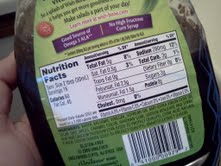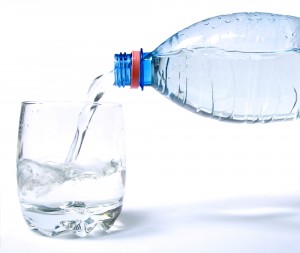Posts Tagged ‘healthy lifestyle’
You’ve probably read the phrase “smart substitutes” in some of my previous posts. If you’re trying to lead a healthier lifestyle or lose some weight (or both), then these two simple words can change everything for you. Take them to heart and know that by choosing a few “smart substitutes” on a consistent basis, you make some pretty big changes without feeling much sacrifice.
 Making smarter choices by going with substitutes for foods higher in fat or calories requires a little detective work, but you can handle it. You’ve got to read labels. Yes, I know you’re often in a hurry at the grocery, but simply grabbing what’s handy, on sale, or new is not a component of a healthy lifestyle.
Making smarter choices by going with substitutes for foods higher in fat or calories requires a little detective work, but you can handle it. You’ve got to read labels. Yes, I know you’re often in a hurry at the grocery, but simply grabbing what’s handy, on sale, or new is not a component of a healthy lifestyle.
Think of the grocery as a peaceful time to focus on your goals. Give yourself some extra time to read labels, make carefully considered choices, and to picture yourself healthier and happier. Exercising control over your food purchases means a far riskier situation at home, health-wise. With smart shopping choices being made in the store, healthier nutrition becomes much easier at home, whether you’re grabbing a snack or cooking a meal from scratch. Simple modifications to your menu – using smart choices – can literally save hundreds of calories and tons of fat.
The biggest label no-no is sugar. If sugar (or a form of sugar) is one of the first three ingredients listed on a package, that likely means that particular food or drink is very high in sugar. Choose a substitute.
Give yourself a double boost by eating wisely at breakfast to kick-start your day. Replace pork bacon or sausage with turkey or soy. The difference in calories is shocking, and the taste is still there.
Replace a donut or Danish with an English muffin spread with natural peanut butter and fruit spread. I promise you, you’ll be satisfied. Opt for whole wheat toast or bagels, and trans-free canola margarine instead of butter. Omega-3-enriched eggs, egg whites or egg substitutes are also smart substitutes. Replace cornflakes and milk with bran flakes and skim millk.
Light mayo is crucial to weight maintenance; keep it in the fridge. Turn your breaded chicken or fish patties into the grilled variety, and try some of today’s amazing veggie burgers. Don’t tell the family up front they’re about to experience a change; there’s every chance the new flavors will appeal.
Side dishes can add loads of unnecessary fat and calories. Substitute brown rice, steamed veggies, tossed salad with vinaigrette, fruit salad or carrot sticks for fries, potato salad, or white rice. Have you noticed how many white foods I’m recommending a substitute for?
Your new favorite words are broiled, boiled, steamed, sautéed, grilled, and raw. Think of them as six wonderful, tasty, life-enhancing alternatives to one artery-clogging, fat-producing word: “fried.”
After all, isn’t that the point? You want to enhance your life, to feel good and have longevity to enjoy all the great things that might come your way. Start at 20, 40, or 60 … but just start. You only get one go-around!
Side Dishes
Coleslaw Tossed salad w/ vinaigrette dressing
French fries Fruit salad or carrot sticks
French fries Oven fries or baked potato
Potato salad with mayo Potato salad with light mayo
Fried vegetables Steamed vegetables
White rice Brown rice or wild rice
Couscous Whole wheat couscous or quinoa
Dinner Entrees
Breaded fried chicken breast Skinless roasted chicken breast
Breaded fried fish Broiled fish filet
Breaded fried shrimp Boiled or sautéed shrimp
Beef ribs or prime rib Beef sirloin or round steak
Pork chops Turkey breast
Meat pizza with extra cheese Veggie pizza with less cheese
Pasta with cream sauce Pasta with marinara sauce
Regular ground beef Extra lean ground beef
Regular ground beef Ground turkey breast
Regular ground beef Veggie burger crumbles
Sauces
Creamy salad dressing Vinaigrette salad dressing
Creamy salad dressing Olive oil and vinegar
Cream sauce Lowfat cream of mushroom soup
SpreadsRegular mayonnaise Light or nonfat mayonnaise
Regular cream cheese Light or nonfat cream cheese
Regular peanut butter Natural peanut butter
Jelly or jam Fruit spread or apple butter
Dairy Products
Whole ricotta cheese Nonfat ricotta cheese
Heavy cream Evaporated skim milk
Whole milk Low fat or nonfat milk
Whole yogurt Low fat or nonfat yogurt
Whole cottage cheese Low fat or nonfat cottage cheese
Regular cheese Reduced fat or soy cheese
Regular sour cream Light or nonfat sour cream or plain yogurt (for extra calcium)
SnacksRoasted peanuts Homemade mix: walnuts, almonds, raisins, cranberries, peanuts
Regular butter popcorn or “kettle corn” Light microwave popcorn
Regular potato chips Light or baked potato chips
Regular corn chips Light or baked tortilla chips
Butter flavor crackers Whole wheat crackers
Nacho cheese dip Black bean dip or salsa
DessertsRegular ice cream Low fat or nonfat frozen yogurt
Ice cream bar Frozen fruit bar
Milk chocolate candy bar Dark chocolate candy bar
Cheesecake Graham crackers topped with light cream cheese and strawberry spread
Fruit pie in pastry shell Fresh fruit crisp
Strawberries with custard Strawberries with nonfat pudding
Candy bar Granola bar
Whether you’re trying to lose weight, lower your sugar intake for overall well-being, or wean your kids off sugar, you need to recognize sugar in its many forms. It’s amazing how many different words mean “sugar” on the contents label of a food or drink.
It’s also unbelievable how many food products include sugar in one form or another. To boost to your wellness plan, you have to know sugar terminology, and you have to know how to interpret the label (and teach your kids). The top three ingredients listed on the label are primary, so if you see a sugary term there, the product is loaded.
Some ingredients to watch out for: corn sweeteners, evaporated can juice, cane sugar, high fructose corn syrup, confectioner’s sugar, dextrin, honey, invert sugar, maple sugar, raw sugar, malt molasses, turbinado sugar, brown and white sugars.
I was also taught, while earning my dietitian degree, that “if it ends in OSE, it means sugar.”
Sucrose, lactose, dextrose and maltose … Watch out!
Sugar has invaded many products where you don’t expect to find it. I’m talking about things such as salad dressings, canned foods, pasta sauces, lunchmeats, “healthy” cereals and granola bars, dried fruit snacks, and more.
It’s no wonder the average American consumes 128 pounds of sugar per year. Prepared foods are hiding pounds of sugar, and adding pounds of fat, especially to our kids, who are at grave risk for diabetes. (Ouch, that hurts me to just write that).
Hopefully you’re aware how much sugar is packed into a regular soda, but sports and energy drinks are culprits that often fly under the radar. Because their purpose is “beneficial,” these drinks make it easy to forget that their labels are also important. But that 20-ounce Powerade you rely on to hydrate you has more than 8 teaspoons of sugar in it!
Some other big offenders (teaspoons of sugar per drink in ounces)
- Propel: 1.5 tsp per 16 ounces
- Vitamin Water: 7 tsp per 20 ounces (this one surprised me).
- Regular Powerade: 8.3 tsp per 20 ounces *
* Powerade and Gatorade do have low sugar options.
Sports Drinks
- Full Throttle: 13.8 tsp per 16 ounces
- Jolt Energy: 22.3 tsp per 23.5 ounces
- Amp: 7.3 tsp per 8.4 ounces
- Monster: 12.8 tsp per 16 ounces
Other drinks that pack in the sugar
- 7-up: 9 tsp sugar per 12 ounces
- A & W Cream Soda: 11 tsp sugar per 12 ounces
- Average cola: 10 tsp per 12 ounces
- Nestlé’s Ice Tea: 8-14 tsp sugar per 16-20 ounces
The bottom line: high sugar intakes are contributing to an epidemic of obesity in this country.
 We’ve all heard certain “facts” about nutrition so many times that we take them at face value, no longer questioning their validity. I’m going to knock a hole in a few of the things we “know” to be true about food.
We’ve all heard certain “facts” about nutrition so many times that we take them at face value, no longer questioning their validity. I’m going to knock a hole in a few of the things we “know” to be true about food.
Let’s start with the food that’s hardest to avoid: sugar. Those who’ve ever attempted the Atkins Diet or simply tried to avoid sugar probably got a rude awakening when they started reading labels. Sugar is hiding everywhere: lunch meat, ketchup, salad dressings. The average person in the U.S. consumes about “128 pounds” a year, or 34 teaspoons a day. Super-size fountain drink, anyone?
But what about sugar causing hyperactivity in kids? Controlled studies prove that’s false. And doesn’t eating sugar put a person at risk for diabetes? No. What causes diabetes is lack of activity, being overweight and a high-calorie diet. Diabetes patients have to cut way down on sugar, but just don’t go there.
Perhaps you’ve heard that brown sugar is healthier than white sugar. Sorry to disappoint, but brown sugar is white granulated sugar with molasses added. The mineral content between the two is insignificant at the end of the day.
Sugar is a refined food that’s been stripped of fiber, water, vitamins and minerals. Avoid foods that list a variant of it as its first three ingredients. This includes dextrose, lactose, sucrose and maltose. Sugar is calories without nutrients, so picture that 128-pound pile and try to make a dent in it.
The “brown vs. white” myth has carried over into the egg department as well. While they may look more natural, brown eggs have no additional nutritional benefits over white. Nor are they higher quality or more flavorful. Hen color determines the eggshell color. White feather hens lay white eggs; red feather hens lay brown eggs.
While we’re on the subject of protein, I’ll dispel a few other myths.
Low-carb diets will cause temporary weight loss but are not a good long-term idea. You may end up ingesting too much cholesterol, which ups the risk of heart disease. Too few fruits and whole grains can lead to a lack of fiber and constipation. Too few carbs can also make a person feel tired, weak or nauseous. Being wobbly at a party can really detract from a girl’s beautiful size 6 cocktail dress.
Another risk of too few carbs is the buildup of ketones in your blood. The kickoff of the Atkins diet is designed to put your body “in ketosis” … but over time, these ketones cause the body to produce a lot of uric acid, a risk factor for joint swelling (gout) and kidney stones. You’ll also notice your new bad breath, and your friends may too.
Ketosis makes the body use fat instead of carbs as an energy source. The weight you lose may well be lean muscle and water. So much better to reduce calories, fat and exercise.
Final myth: cabbage soup and grapefruit burn fat. Nope, sorry, reread the last few paragraphs. You’ll just lose water weight, lean muscle and feel tired and queasy. And that’s the truth!
Exercise requires energy, pure and simple. But where does it come from? The answer is glycogen. But what is it?
 When we digest food we’ve eaten, the carbohydrates are broken down by our bodies into glucose, and then the glucose is stored in our muscles . . . as glycogen. During periods of exercise, this process reverses, and glycogen converts to glucose once again, so that is may be used for energy. How long we “last” is greatly influenced by how much glycogen we have stored in our muscles.
When we digest food we’ve eaten, the carbohydrates are broken down by our bodies into glucose, and then the glucose is stored in our muscles . . . as glycogen. During periods of exercise, this process reverses, and glycogen converts to glucose once again, so that is may be used for energy. How long we “last” is greatly influenced by how much glycogen we have stored in our muscles.
Exercise that lasts less than 90 minutes is typical for most of us. Carbs typically provide 40-50% of our energy in the beginning stages of moderate exercise. What the body naturally stores will sustain you through a workout of this length.
But as the intensity of physical activity increases, the body’s carbohydrate consumption increases too. For events over 90 minutes, eat a heavy-carb diet for 2-3 days prior.
Picture the muscles like porous rocks. The more glycogen is filling all those crevices, the more energy reserves we have to draw upon. This is why cyclists, marathoners, triathletes, soccer players and other endurance athletes excel when they’ve pre-loaded for 2-3 days with about 70% carbs. Glycogen is the fuel which sustains the body in highly physical situations.
Have you heard the term “hitting the wall?” This refers to an actual event in the body, the depletion of glycogen. Once stores are gone, energy is truly kaput; you have no way to generate more.
Don’t assume you should eat a high-carb diet all the time, though, even if you exercise heavily. Once glycogen fills all the areas where reserves can be stored, any extra that is produced is stored as body fat. Eating too many carbs causes this excessive glycogen production.
Another danger of overdoing carb consumption: you can unwittingly “train” your body not to utilize essential fatty acids that come from fat. Not only does fat transport cholesterol and play a role in blood clotting, it helps us absorb vitamins and produce hormones.
Conversely, eating too few carbs forces the body to use protein for energy. The body will actually start to break down protein – the building blocks for muscles, bone, and other tissues – meaning you put yourself into a sort of self-cannibalization. Your body starts to feed on its own muscles and you lose muscle mass. This is also tough on kidneys. Not a pretty thought.
So strike a happy balance between protein, carbs and fat, and remember lean protein, high fiber and unsaturated fats as your first choice. It’s all about balance and timing: my 80/20 rule. Athletic training is 80% nutrition, 20% training. Get the food right, you have a bonafide mega-advantage over the competition.
Michelle Ciuffetelli, a Certified Personal Trainer in Fort Myers, Florida, says her favorite carbs are oatmeal (filling and a good source of fiber); sweet potatoes; fruit (a great snack); Arnold Sandwich Thins (good fiber); and Flat Out wraps (taste great, can wrap anything).
Now get moving. That’s a wrap!
 What cyclists eat and drink determines how fast and how far they can ride. What are your goals? Recreation, competitive racing, or heavy-duty triathlons? Even recreational riders should pay attention to their diet; maximize your ride and get the body you want. All athletes and exercisers need energy to function.
What cyclists eat and drink determines how fast and how far they can ride. What are your goals? Recreation, competitive racing, or heavy-duty triathlons? Even recreational riders should pay attention to their diet; maximize your ride and get the body you want. All athletes and exercisers need energy to function.
Many cyclists avoid caffeine, knowing it’s a diuretic, but here’s a surprise. During endurance exercise, the dehydrating qualities of caffeine are practically nil with small amounts of caffeine. And studies have shown that it may help the body burn fat, rather than carbohydrate reserves.
Coffee is not an ideal source of caffeine for exercisers or athletes – therefore, don’t think you can justify your Starbucks habit. We have only 1,500-3,000 calories of reserve carbs, but the body stores 70,000 fat calories at any given time, so burn, baby, burn.
Each hour of an intense bike ride will use 500-1,000 calories. Your overall protein needs will increase during exercise; supplement at 1.2-2. g protein per kilogram of body weight per day depending on your intensity and length of exercise.
For endurance events, you can increase your carbs three days prior. This maximizes the body’s glycogen stores. While you ride, you need 30-60 g of carbs for each hour beyond the first hour. An energy bar works.
Practice eating while you ride and don’t change your food choice on race day. Remember, fat can contribute as much as 75 percent of your energy demands during endurance training. Keep foods simple.
During a ride in hot weather, the body’s ability to digest becomes compromised. Liquid foods avoid this situation, and keep you speeding along without much hassle. Certain energy drinks can fill the bill, as does an Ensure protein drink, available in any drug store.
Ensure also comes in powder form; having baggies of it allows you to add it to water, drink a meal, and continue on. You can also mix fruit juice and water for a source of hydration, carbs and sugar for your blood.
How’d you like to burn 350-500 calories per hour, doing something that’s refreshing and widely available? If your answer’s yes, then go put on your swimsuit and keep reading. Swimming is great exercise, whether you do it casually or in a serious, “endurance sport” manner.
 Triathletes must make diet their primary focus if they want to significantly improve their performance. But for any type of athletic conditioning, nutrition is at least 80 percent of the formula, and training makes up no more than 20 percent.
Triathletes must make diet their primary focus if they want to significantly improve their performance. But for any type of athletic conditioning, nutrition is at least 80 percent of the formula, and training makes up no more than 20 percent.
Keys to the 80/20 formula are quality, quantity, and timing of nutrients … learning not only what to eat but also “how and when” will maximize results in triathlons, multiple-sport activities, and even for recreational exercisers. Developing good eating habits every day can make the difference between great training/exercise/events, and just struggling through.
Note that I said “habits.” Eating well can become a habit over time, one you no longer have to think about, or feel burdened by in any way. Commit to the concept of positive, life-enhancing, sport-enhancing long-term change through diet, and over time, you will develop this good habit just as easily as people develop bad ones.
Now, back to the pool. Is there any truth to the phrase “no swimming until one hour after you’ve eaten?” Yes, a bit, but only if you’re planning on swimming with extreme intensity, as in a triathlon.
Recreational swimming falls in a different category. You, your children or grandchildren can all swim or play in the pool after eating. Frolicking with a full belly is perfectly safe.
In fact, if you plan to swim in the morning – especially just after rising from a night’s sleep – eat something. Engaging in vigorous exercise on an empty stomach will cause you to suffer. You’ll feel weak, possibly dizzy, perhaps sick to your stomach. Certainly your workout will be a poor one and most likely will have to be cut short.
After sleep, your blood sugar is low. So have a snack before you hit the pool.
Swimming is less demanding than running or cycling for pre-activity nutrition. Even fruit, toast or a sports drink will do, to elevate the blood sugar a bit. Hydration before or during swimming is not much of an issue because you won’t overheat in water, but hydration after swimming restores electrolyte balance.
In all three triathlon sports, post-workout nutrition should occur within 30 minutes of stopping, when the body is most receptive to carbs for replacing glycogen lost during the workout. Ingesting protein will help muscles recover and rebuild stronger.
Women swimmers especially need to be aware of the potential for iron and/or calcium deficiencies. Lacking either or both of these essential minerals will affect performance.
Remember the 80/20 rule and decide now to develop good habits. It does not matter how hard or how much you exercise; good nutrition and healthy eating habits are the crucial component. Next week we’ll discuss nutrition for cycling.
Whether you’re a triathlete, a recreational or endurance runner, or even a power walker, your body relies on proper fuel to do what you ask it to do. Training will take you only so far, no matter how religiously you do it. Here’s a surprising statistic I mentioned last week: nutrition counts for 80 percent of athletic training.
 A total of 45-65 percent of runners’ and walkers’ diets should be carbohydrate-rich foods. Carbs give us quick and long-lasting energy. They’re also easier for the body to use than proteins or fats.
A total of 45-65 percent of runners’ and walkers’ diets should be carbohydrate-rich foods. Carbs give us quick and long-lasting energy. They’re also easier for the body to use than proteins or fats.
I’ve always been an advocate of eating whole-grain foods – breads and pastas, wild rice, veggies, beans and oatmeal – but you must read labels carefully. Whole wheat does not equal whole grain.
Runners also need “good” fats, typically 20-30 percent of daily intake. Fat is energy for muscles, once quick-burning carbs have been used. Avoid trans fats. Heart-healthy omega-3s come in walnuts, flax seeds, cold-water fatty fish, soybean and canola oils and even tofu.
Don’t forget protein. A total of 15-35 percent of a runner’s diet should be lean proteins such as fish, poultry, low-fat dairy, nuts and seeds. Avoid foods high in saturated fats and cholesterol.
Find the percentages that work for you, and remember: hydration is key to the formula, and timing is everything. Drink early: do NOT wait for thirst to set in. Think of hydration as a pro-active commitment, not as a fix for thirst. Watch your urine: if it’s pale, you’re drinking enough water.
Always choose a pre-exercise meal that’s low in fat and fiber, is high carbohydrate and includes moderate protein. That’s the formula for endurance and energy.
While running, consume approximately 8 ounces of water every 15 minutes. If you’re exercising longer than an hour, alternate water and Gatorade about every 15-20 minutes. For high intensity workouts, I also suggest a sports drink like G2 (Gatorade2).
After running, you need 3 cups of fluid for every pound lost. Your body also needs protein and carbs (like chocolate milk and trail mix). A protein boost within 15-20 minutes of ending your workout will dramatically affect how your muscles rebuild and replenish.
The time period right after exercise – your short-term “recovery” window – is the most critical for improving your body. Training breaks down muscles, literally, and depletes natural energy stores (glycogen). During recovery, muscle tissue begins to repair and in so doing, strengthens. Energy replenishes.
Timing is key. Your short-term recovery window is only about 45 minutes, and can be wasted during a post-workout chat and/or drive home. Once this window closes, your muscles will no longer be receptive to the nutritional assistance you could have provided.
Bottom line: have a snack immediately following a workout that contains carbohydrate and protein, for this critical period. You’ll start to see a real change in your muscle tone, endurance and energy.
A good post-exercise meal, within 60-90 minutes, could be salmon, brown rice, broccoli, peppers and carrots. Let your body enjoy long-term recovery on “no-workout” days, while you focus on a healthy diet. And don’t skip meals. I personally eat six small meals a day.
Next week: nutrition for swimmers.
Ever heard the term “Weekend Warriors?” These fun-loving, sports-minded folks work hard then occasionally decide to have some fun by participating in an activity that’s new (or old and dear). The problem is, their body isn’t conditioned through diet and exercise for what’s about to happen, and the result is often an injury … sometimes a bad injury.
Common catalysts for weekend warrior syndrome are spring thaw, reunions, holidays, turning 40, turning 50, New Year’s resolutions and your teen’s friends playing ball in the lot next door. There are abundant opportunities to “jump right in” and although your heart’s in the right place, you could pay a big price later.
I’ve fallen victim to this scenario myself. I work out on a regular basis and eat well, but recently I played a charity softball game, a sport that I used to play in my younger years … and I could not get out of bed on Monday. I also could not use my Blackberry because my hands hurt so bad.
Had I at least been doing some type of similar activity before that game, or stretching the body parts I knew I’d be using, I might have had a fighting chance. Changing from a flat gym floor to uneven earth or rolling trails or sloped beaches can also cause issues. Imagine what the 50th-birthday-but-20-mile-bike-ride might do to an office worker.
If we’re not used to using certain muscles, we make ourselves prime candidates for debilitating or highly irritating injuries. I was thinking about the various ways to keep the body prepared for the occasional odd activity, and came across a great quote on the Internet: “Men over 40 should be fit for their sport rather than using their sport to get fit,” it said. This surely applies to everyone contemplating a sudden, big burst of athleticism.
The easiest way to avoid injury is the one requiring the most discipline: don’t do too much of anything that’s new. Start out in moderation, play part of the game, do 5 miles instead of 20. You could save yourself a stress fracture or a couple of very uncomfortable weeks.
Flexibility and stretching are key, too, so if you know you have a new sport ahead, start working that part of the body, stretching daily, and always stretch after a workout to gain flexibility. A balanced diet and proper weight is always a good idea. Hauling an extra 30 pounds around a make-believe football field is tough.
Here’s another tip: A lack of magnesium can lead to muscle weakness and cramps. Magnesium is lost via sweat, so regular exercisers and even saunagoers need to take in enough magnesium rich foods or supplement magnesium. But after a spontaneous workout, you’d do well to have some on hand.
Weekend warriors can benefit from maintaining a healthy mineral balance. Think of magnesium as your “muscle mineral.” The FDA recommends 310-420 mg daily for most adults.
Here are a few magnesium-rich foods if, like me, you prefer a healthy diet to taking lots of supplements: 3 ounces of halibut, 90 gm; 1 ounce dry roasted almonds, 80 gm; 1 ounce dry roasted cashews, 75 gm; 1/2 cup cooked soybeans, 75 gm; 1/2 cup frozen spinach, 75 gm; 1 ounce mixed dry roasted nuts, 65 gm; 2 biscuits of Shredded Wheat cereal 55 gm; 1 cup instant fortified oatmeal, 55 gm.
I also like to keep resistance bands all around me: tied to doors, in my travel bag, in front of the TV, wrapped around the legs and arms of my chairs. A good 10-minute workout with bands can be great if done right.
So if your college roomie has challenged you to a tennis rematch from days gone by … start working the “pushing” muscles on your chest wall, and get your shoulder primed for action. Do some sideways motion drills, and start taking magnesium. If it’s been a while, you’re going to need it!
 In my last column, I explained that whey protein is often a problem for lactose-intolerant people who are using a protein supplement. It’s easy to assume that a protein supplement is beneficial for only extreme athletes such as bodybuilders, but that couldn’t be farther from the truth.
In my last column, I explained that whey protein is often a problem for lactose-intolerant people who are using a protein supplement. It’s easy to assume that a protein supplement is beneficial for only extreme athletes such as bodybuilders, but that couldn’t be farther from the truth.
Protein has many uses and supplementation is beneficial for a wide variety of users. They include the elderly; those with joint or degenerative diseases, or orthopedic conditions; the overweight; people who do heavy manual labor in their work, sport or hobby; those going through growth phases; people in physical rehab; men and women doing intensive training for a sport or competition; adults who work out on a regular basis; teen athletes who are trying to build muscle and strength; people taking symptomatic treatment for pain relief or inflammation; and anyone with pain resulting from excessive joint stress. Hardly anyone you know doesn’t fit onto that list somewhere.
The trick is getting that extra protein without absorbing a lot of extra calories, fillers or dairy products (as in the case of whey protein powder).
Collagen is a great way to get added protein. Did you know that collagen is the second-largest component of the human body after water? It’s a protein, and one found in muscles, joints, ligaments, tendons, bones and more.
Historically, physicians have used collagen to treat skin trauma, such as burns and wounds. But collagen also affects the hair, nails and overall healthy appearance of skin, which is why you see it advertised in high-end skin care products.
As we age, our bodies stop producing collagen protein, and sadly, it’s collagen that gives our skin elasticity. So the appearance of dry, wrinkled skin is really the lack of collagen. Supplementing your diet with a natural source of collagen protein doesn’t just make you more youthful looking, however. Collagen builds lean healthy muscle – the muscle of youth – as well as healthy joints and bones. Can you think of a better supplement to give the special elders in your life?
Collagen protein also helps aid in the repair of muscle tissue. Because a good workout or physical exercise is actually breaking down the body’s muscles, collagen protein assists in the rebuilding process. Collagen makes it possible to heal faster, simultaneously building leaner muscle, following a workout. Some will even find they sleep more soundly when taking collagen protein. Sounds better all the time, doesn’t it?
You may wonder why a person can’t just eat more protein and gain the same benefits. It’s about bioavailability. Protein in food form has calories, of course, and a healthy daily diet only contains so many. The bioavailability of the protein also comes into question. By the time your body works to chew and digest the food, you’re not getting nearly as much protein as the amount you started with on your plate.
A powder form can provide extra protein without as much work for the body, but comes with the added calories of what it’s poured into. A liquid protein is your best bet. Find one that’s small in calories, and better yet, hydrolyzed – or “predigested” – which simply means that you ingest it in its smallest form, with no extra work for the body to break it down.
I encourage you to join me – and my husband and my teenage son – and add a low-cal collagen protein supplement to your diet. You could be amazed at the changes you experience. See the developing abs on the teen in the photo? That’s my son Cody, who drinks a liquid collagen protein supplement and works out regularly.
- Elaine Hastings is a registered dietitian, sports nutrition authority, and and owner of Associates in Nutrition Therapy in Fort Myers, Florida. She can be contacted at Elaine@eatrightRD.com or by visiting Associatesin Nutrition.com.
Article makes American Dietetic Association newswire…Nutrition: RD credentials signify specialized training
My latest News-Press article made the ADA’s news service! Be sure to read the article below on the significance of RD credentials. You can also link to the ADA’s Web site at www.eatright.org. They have the very latest news on food and nutrition. With so much information on the Web, it’s important to find credible sources. The ADA is a valuable resource for both health care professionals and consumers.
There is so much emphasis on the importance of food and nutrition that it is understandable why consumers may be confused. Who are you getting your nutrition advice from? Your gym? Magazines? A weight-loss program? The Web?
All of these sources can offer valuable information; however, you need to know that some of the advice you will receive from them is not necessarily accurate. New diet recommendations constantly emerge, making it sometimes difficult to distinguish fact from fiction. You should be especially careful if anyone offers you quick fixes that seem too good to be true.
If you are confused about the science of nutrition and weight loss, or have been receiving conflicting advice and not seeing the results you want, consider making an appointment with a registered dietitian, a specialist in the study of nutrition, who can assist you with planning a diet to promote a healthy lifestyle.
Certified by the state, RDs undertake the practical application of nutrition to prevent nutrition-related problems.
They are also involved in the diagnoses and dietary treatment of disease.
Dietitians in many settings work with people who have special dietary needs, inform the general public about nutrition, give unbiased advice, evaluate and improve treatments and educate clients, doctors, nurses, health professionals and community groups.
Sometimes, RDs will refer to themselves as “nutritionists,” because it is a term the public is familiar with. However, not all “nutritionists” are necessarily RDs.
Make sure the person you choose to see has RD credentials to ensure that person has received the necessary specialized accredited training.
That training includes classes in food and nutrition sciences, food service systems management, business, economics, computer science, culinary arts, sociology, chemistry, communications, education, biochemistry, anatomy and physiology, microbiology, pharmacology and psychology.
To make the transition from dietitian to RD requires the completion of an internship and the successful passing of a national board exam.
Why should you consider a dietitian instead of relying on the trainers at your local gym or your monthly fitness magazine? Dietitians have special skills in translating scientific and medical decisions related to food and health to inform the general public. They also play an important role in health promotion.
A dietitian will work with your doctor to assist you in fine-tuning your medications, meals and exercise requirements. Dietitians also will be able to assist you with reading food labels, and provide cooking and grocery tips.
Elaine Hastings is a registered dietitian of Associates in Nutrition Therapy in Fort Myers. She has been practicing for 15 years and was recently named president of the Southwest Florida Dietetic Association. A “nutrition entrepreneur,” she works contractually and is also a writer, motivational speaker, product researcher, counselor, sports-nutritionist and eating disorder advocate. Continue to read her series on Tuesdays. You can contact Elaine at www.AssociatesinNutrition.com, Call her at 239-275-2132 or Email her at Elaine@associatesinnutrition.com



Follow Us!